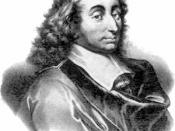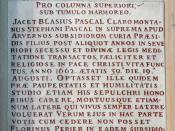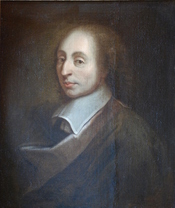Pascal was a child prodigy, who was educated by his father. He was a mathematician of the first order. At 16 he wrote the Essai pour les coniques which was published in 1640. In 1642 he invented a calculating machine to help his father, who served as Royal Tax Commissioner at Rouen. Pascal is often credited with the discovery of the mathematical theory of probability, and he also made serious contributions to number theory and geometry.
In 1646 Pascal learned of Toricelli's experiments with the barometer and the theory of air preassure. These experiments involved placing a tube of mercury upside down in a bowl of mercury. Pascal repeated Toricelli's experiments and did more work which led to the publication of Experiences nouvelles touchant le vide in 1647. Aristotle had argued against the atomists that nature abhors a vacume. This was a view still strongly held in the seventeenth century, even by such anti-Aristotelians as Descartes and Hobbes.
In the Experiences Pascal explains the reasons why a genuine vacume could and did exist above the mercury in the barometer. In defending these conclusions against Father Noel, rector of the College de Clermont in Paris, Pascal gave one of the clearest statements of scientific method in the seventeenth century.
Pascal became involved with a religious movement in France know as Jansenism after its founder Cornelis Jansen (1585-1636) in 1646 when Pascal's father had an accident and was cared for by Jansenists. After Pascal's father died in 1651, his sister became a nun at a Port Royal convent run by the Jansenists. From 1652 to 1654 Pascal turned away from religious interests spending his time with gamblers, womanizers and free thinkers. However, on the night of Nov. 23, 1654 Pascal had a conversion experience. In 1655 Pascal metAntoine Arnauld who was the...


